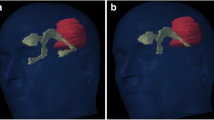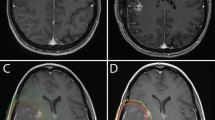Abstract
Purpose
Tumors involved with subventricular zone (SVZ) predicted an adverse prognosis had been well proved in adult glioblastoma (GBM). However, we still know less about its impact on children due to the rarity of pediatric glioblastoma (pGBM). We performed this retrospective study to better understand the clinical and prognostic features of pGBM involved with SVZ.
Methods
Fifty-two patients diagnosed with pGBM at our center between January 2011 and January 2021 were selected for review to demonstrate the characteristics of tumor contacting SVZ. Thirty patients who underwent concurrent chemoradiotherapy and adjuvant chemotherapy postoperatively were selected for survival analysis.
Results
Of all the 52 patients, 21 were found to contact SVZ and 31 were not. The median PFS and OS in SVZ + patients were 5.2 and 8.9 months, respectively, whereas median PFS and OS were 11.9 and 17.9 months, respectively, in SVZ − patients. Multivariate analysis showed that involvement of SVZ was an independent prognostic factor for OS while focality at diagnosis was an independent prognostic factor for PFS. Tumors contacted with SVZ tend to have larger volumes, lower incidence of epilepsy, and lower total resect rate and they were more likely to originate from midline location. Age at diagnosis; gender; adjuvant therapy; focality at diagnosis; focality at relapse; mutational status of H3K27M, MGMT, IDH1, and IDH2; and expression of P53 and ATRX protein failed to characterize SVZ + patients.
Conclusion
Involvement of SVZ predicted worse OS in pGBM and it had some distinct clinical features in comparison with those that did not contact with SVZ. Multifocal tumor at diagnosis was related to a shorter PFS. We should make a further step to clarify its molecular features.




Similar content being viewed by others
Availability of data and material
The datasets used during the current study are available from the corresponding author on reasonable request.
Abbreviations
- SVZ:
-
Subventricular zone
- MID:
-
Midline
- HEM:
-
Hemisphere
- pGBM:
-
Pediatric glioblastoma
- GBM:
-
Glioblastoma
- HGGs:
-
High-grade gliomas
- PFS:
-
Progression-free survival
- OS:
-
Overall survival
- EOR:
-
Extent of resection
- RT:
-
Radiotherapy
- CT:
-
Chemotherapy
- MRI:
-
Magnetic resonance imaging
- IDH:
-
***Isocitrate dehydrogenase
- DWI:
-
Diffusion-weighted images
References
Lee JH, Lee JE, Kahng JY et al (2018) Human glioblastoma arises from subventricular zone cells with low-level driver mutations. Nature 560243–7. https://doi.org/10.1038/s41586-018-0389-3
Sanai N, Alvarez-Buylla A, Berger MS (2005) Neural stem cells and the origin of gliomas. N Engl J Med 353811–22. https://doi.org/10.1056/NEJMra043666
Wang Y, Yang J, Zheng H et al (2009) Expression of mutant p53 proteins implicates a lineage relationship between neural stem cells and malignant astrocytic glioma in a murine model. Cancer cell 15514–26. https://doi.org/10.1016/j.ccr.2009.04.001
Berendsen S, van Bodegraven E, Seute T et al (2019) Adverse prognosis of glioblastoma contacting the subventricular zone: Biological correlates. PloS one 14e0222717. https://doi.org/10.1371/journal.pone.0222717
Jungk C, Warta R, Mock A et al (2019) Location-dependent patient outcome and recurrence patterns in IDH1-wildtype glioblastoma. Cancers 11. https://doi.org/10.3390/cancers11010122
Mistry AM, Dewan MC, White-Dzuro GA et al (2017) Decreased survival in glioblastomas is specific to contact with the ventricular-subventricular zone, not subgranular zone or corpus callosum. J Neurooncol 132341–9. https://doi.org/10.1007/s11060-017-2374-3
Mistry AM, Mummareddy N, CreveCoeur TS et al (2020) Association between supratentorial pediatric high-grade gliomas involved with the subventricular zone and decreased survival: a multi-institutional retrospective study. J Neurosurg Pediatr 1–7. https://doi.org/10.3171/2020.3.PEDS19593
Stupp R, Mason WP, van den Bent MJ et al (2005) Radiotherapy plus concomitant and adjuvant temozolomide for glioblastoma. The New England journal of medicine 352987–96. https://doi.org/10.1056/NEJMoa043330
Erker C, Tamrazi B, Poussaint TY et al (2020) Response assessment in paediatric high-grade glioma: recommendations from the Response Assessment in Pediatric Neuro-Oncology (RAPNO) working group. The Lancet Oncology 21e317-e29. https://doi.org/10.1016/s1470-2045(20)30173-x
Adeberg S, Bostel T, König L, Welzel T, Debus J, Combs SE (2014) A comparison of long-term survivors and short-term survivors with glioblastoma, subventricular zone involvement: a predictive factor for survival? Radiation oncology (London, England) 995. https://doi.org/10.1186/1748-717x-9-95
Chaichana KL, McGirt MJ, Frazier J, Attenello F, Guerrero-Cazares H, Quinones-Hinojosa A (2008) Relationship of glioblastoma multiforme to the lateral ventricles predicts survival following tumor resection. J Neurooncol 89219–24. https://doi.org/10.1007/s11060-008-9609-2
Comas S, Luguera E, Molero J et al (2021) Influence of glioblastoma contact with the subventricular zone on survival and recurrence patterns. Clin Transl Oncol 23554–64. https://doi.org/10.1007/s12094-020-02448-x
Lim DA, Cha S, Mayo MC et al (2007) Relationship of glioblastoma multiforme to neural stem cell regions predicts invasive and multifocal tumor phenotype. Neuro Oncol 9424–9. https://doi.org/10.1215/15228517-2007-023
Mistry AM, Hale AT, Chambless LB, Weaver KD, Thompson RC, Ihrie RA (2017) Influence of glioblastoma contact with the lateral ventricle on survival: a meta-analysis. J Neurooncol 131125–33. https://doi.org/10.1007/s11060-016-2278-7
Bao S, Wu Q, McLendon RE et al (2006) Glioma stem cells promote radioresistance by preferential activation of the DNA damage response. Nature 444756–60. https://doi.org/10.1038/nature05236
Blough MD, Westgate MR, Beauchamp D et al (2010) Sensitivity to temozolomide in brain tumor initiating cells. Neuro Oncol 12756–60. https://doi.org/10.1093/neuonc/noq032
Chen J, Li Y, Yu TS et al (2012) A restricted cell population propagates glioblastoma growth after chemotherapy. Nature 488522–6. https://doi.org/10.1038/nature11287
Dedobbeleer M, Willems E, Freeman S, Lombard A, Goffart N, Rogister B (2017) Phosphatases and solid tumors: focus on glioblastoma initiation, progression and recurrences. Biochem J 4742903–24. https://doi.org/10.1042/BCJ20170112
Gimple RC, Bhargava S, Dixit D, Rich JN (2019) Glioblastoma stem cells: lessons from the tumor hierarchy in a lethal cancer. Genes Dev 33591–609. https://doi.org/10.1101/gad.324301.119
Goffart N, Lombard A, Lallemand F et al (2017) CXCL12 mediates glioblastoma resistance to radiotherapy in the subventricular zone. Neuro Oncol 1966–77. https://doi.org/10.1093/neuonc/now136
Piccirillo SG, Spiteri I, Sottoriva A et al (2015) Contributions to drug resistance in glioblastoma derived from malignant cells in the sub-ependymal zone. Cancer Res 75194–202. https://doi.org/10.1158/0008-5472.CAN-13-3131
Wang S, Chen C, Li J, Xu X, Chen W, Li F (2020) The CXCL12/CXCR4 axis confers temozolomide resistance to human glioblastoma cells via up-regulation of FOXM1. J Neurol Sci 414116837. https://doi.org/10.1016/j.jns.2020.116837
Louis DN, Perry A, Reifenberger G et al (2016) The 2016 World Health Organization Classification of Tumors of the Central Nervous System: a summary. Acta Neuropathol 131803–20. https://doi.org/10.1007/s00401-016-1545-1
Hallaert G, Pinson H, Van den Broecke C et al (2020) Subventricular zone contacting glioblastoma: tumor size, molecular biological factors and patient survival. Acta Oncol 591474–9. https://doi.org/10.1080/0284186X.2020.1794032
Elliott JP, Keles GE, Waite M, Temkin N, Berger MS (1994) Ventricular entry during resection of malignant gliomas: effect on intracranial cerebrospinal fluid tumor dissemination. J Neurosurg 80834–9. https://doi.org/10.3171/jns.1994.80.5.0834
Young JS, Gogos AJ, Pereira MP et al (2021) Effects of ventricular entry on patient outcome during glioblastoma resection. J Neurosurg 1–9. https://doi.org/10.3171/2020.7.Jns201362
Pallud J, Capelle L, Huberfeld G (2013) Tumoral epileptogenicity: how does it happen? Epilepsia 54 Suppl 930–4. https://doi.org/10.1111/epi.12440
Fan X, Li Y, Shan X et al (2018) Seizures at presentation are correlated with better survival outcomes in adult diffuse glioma: a systematic review and meta-analysis. Seizure 5916–23. https://doi.org/10.1016/j.seizure.2018.04.018
Harat M, Małkowski B, Roszkowski K (2019) Prognostic value of subventricular zone involvement in relation to tumor volumes defined by fused MRI and O-(2-[(18)F]fluoroethyl)-L-tyrosine (FET) PET imaging in glioblastoma multiforme. Rad Oncol (London, England) 1437. https://doi.org/10.1186/s13014-019-1241-0
Goffart N, Kroonen J, Di Valentin E et al (2015) Adult mouse subventricular zones stimulate glioblastoma stem cells specific invasion through CXCL12/CXCR4 signaling. Neuro Oncol 1781–94. https://doi.org/10.1093/neuonc/nou144
Qin EY, Cooper DD, Abbott KL et al (2017) Neural precursor-derived pleiotrophin mediates subventricular zone invasion by glioma. Cell 170845–59 e19. https://doi.org/10.1016/j.cell.2017.07.016
Lee P, Eppinga W, Lagerwaard F et al (2013) Evaluation of high ipsilateral subventricular zone radiation therapy dose in glioblastoma: a pooled analysis. Int J Radiat Oncol Biol Phys 86609–15. https://doi.org/10.1016/j.ijrobp.2013.01.009
Valiyaveettil D, Malik M, Akram KS, Ahmed SF, Joseph DM (2020) Prospective study to assess the survival outcomes of planned irradiation of ipsilateral subventricular and periventricular zones in glioblastoma. Ecancermedicalscience 141021. https://doi.org/10.3332/ecancer.2020.1021
Iuchi T, Hatano K, Kodama T et al (2014) Phase 2 trial of hypofractionated high-dose intensity modulated radiation therapy with concurrent and adjuvant temozolomide for newly diagnosed glioblastoma. Int J Radiat Oncol Biol Phys 88793–800. https://doi.org/10.1016/j.ijrobp.2013.12.011
Brown CE, Aguilar B, Starr R et al (2018) Optimization of IL13Rα2-targeted chimeric antigen receptor T cells for improved anti-tumor efficacy against glioblastoma. Mol Ther 2631–44. https://doi.org/10.1016/j.ymthe.2017.10.002
Kim DG, Kim KH, Seo YJ et al (2016) Anti-miR delivery strategies to bypass the blood-brain barrier in glioblastoma therapy. Oncotarget 729400–11. https://doi.org/10.18632/oncotarget.8837
Meijer DH, Maguire CA, LeRoy SG, Sena-Esteves M (2009) Controlling brain tumor growth by intraventricular administration of an AAV vector encoding IFN-beta. Cancer Gene TherCancer Gene Ther 16664–71. https://doi.org/10.1038/cgt.2009.8
Panciani PP, Fontanella M, Tamagno I et al (2012) Stem cells based therapy in high grade glioma: why the intraventricular route should be preferred? J Neurol Sci 56221–9
Acknowledgements
We thank all the patients who trusted us and all the physicians and staff who helped this study and authors whose work was referred or quoted in this study.
Funding
This study is supported by the Medical Science and Technology Project of Henan Province (SBGJ202003032).
Author information
Authors and Affiliations
Contributions
Yang Jiao: conceptualization, data curation, writing (original draft preparation); Meng Wang: writing (reviewing and editing); Xueyou Liu: writing (reviewing and editing); Junkuan Wang: writing (reviewing and editing); Yuwei Shou: data curation; Hongwei Sun: supervision, writing (reviewing and editing).
Corresponding author
Ethics declarations
Ethics approval
The implementation of this study has been approved by the ethics committee of the First Affiliated Hospital of Zhengzhou University. The use of data for analysis has been agreed by guardians of every child involved in this study.
Consent to participate
Consent to participate in our study had been obtained from parents of every patient.
Consent for publication
Written informed consent for publication was obtained from all participants.
Conflict of interest
Neither I nor my spouse/partner has a commercial interest, financial interest, and/or other relationship with manufacturers of pharmaceuticals, laboratory supplies, and/or medical devices or with commercial providers of medically related services.
Additional information
Publisher's Note
Springer Nature remains neutral with regard to jurisdictional claims in published maps and institutional affiliations.
Rights and permissions
About this article
Cite this article
Jiao, Y., Wang, M., Liu, X. et al. Clinical features and prognostic significance of tumor involved with subventricular zone in pediatric glioblastoma: a 10-year experience in a single hospital. Childs Nerv Syst 38, 1469–1477 (2022). https://doi.org/10.1007/s00381-022-05522-7
Received:
Accepted:
Published:
Issue Date:
DOI: https://doi.org/10.1007/s00381-022-05522-7




